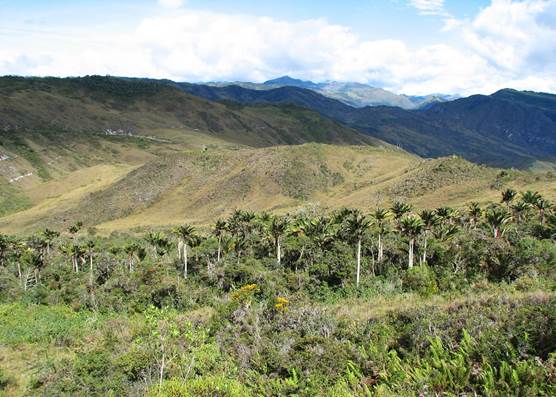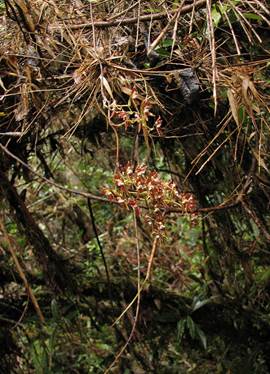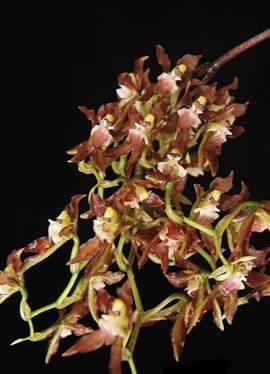Introduction
The Department of Amazonas (here referred to as DoA) is in the northern part of Peru, in the transition zone between the Andes and the Amazonian lowland plains (Fig. 1). This area consists of large tracts of humid and semi-humid forest where the authors have experienced a high diversity in orchids. Since the early nineteenth century, many plant collectors and botanists have been recording the species richness that inhabits the forests of the DoA and other ecologically similar areas in Peru. As a result, numerous new species have been described from these forests, such as Dichaea hutchisonii D.E.Benn. & Christenson, Epidendrum camilo-diazii Hágsater & Chocce, Epidendrum mathewsii Rchb.f., Masdevallia wurdackii C.Schweinf., and Otoglossum weberbauerianum (Kraenzl.) Garay & Dunst. These and numerous other species were named in honor of their collectors (Bennett & Christenson 2001, Hágsater & Sánchez 2010, Kränzlin 1906, Reichenbach 1877, Schweinfurth 1970).
Nevertheless, this unique biological habitat appears to be under intense pressure due to the deforestation that the authors have witnessed over the years. It is estimated that approximately 33% of the surface of the original forest has been altered in the DoA (Reátegui & Martínez 2010); the most deforested zone ranges from the center to the south of the Department. In deforested areas, however, part of the rich original flora is luckily preserved in small patches of original vegetation where even new orchid species can be found (Fig. 2). Here we described one such new species of Cyrtochilum Kunth, discovered in a small fragment of wet montane forest in the southwestern part of the DoA, with second documentation of the same taxon from the Department of Huánuco, Peru.
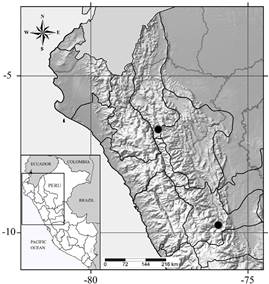
Map composed by Delsy Trujillo using SimpleMappr.
Figure 1 Map showing the known distribution of Cyrtochilum pollex in Peru.
Taxonomic treatment
Cyrtochilum pollex Dalström & D.Trujillo, sp. nov. (Fig. 3 - - 6).
TYPE: Peru. Amazonas: Prov. Luya, Distrito San Francisco del Yeso, Ipaña-Las Palmas, alt. 3055 m, 1 May 2010, D. Trujillo 499 (holotype: MOL).
Diagnosis: Cyrtochilum pollex is similar to C. fidicularium (Dalström) Dalström and C. gracile (Lindl.) Kraenzl., in having an extra thumb-like projection above the rounded ventral lobe of the column. Cyrtochilum pollex differs from C. fidicularium in having more sharply pointed and forward projecting callus keels on the lip and a longer front lobe of the lip versus blunt and downward directed lobes in C. fidicularium. Cyrtochilum pollex differs from C. gracile by the long and wiry inflorescence versus a more sub-erect and straighter panicle in C. gracile.
Epiphytic herb, type plant rather small for the genus, but much larger plants have been observed (SD 3679, 3680). Pseudobulbs caespitose, ovoid, to ca. 5 × 1.5 cm, unifoliate, surrounded basally by 3 to 6 foliaceous sheaths. Leaf conduplicate, petiolate, elliptic, acuminate, ca. 10 × 1.8 cm. Inflorescence axillary from the base of the pseudobulb and the uppermost sheath, wiry, to ca. 70 cm long panicle, with widely spaced side branches carrying clusters of 6 to ca. 15 flowers. Peduncular and floral bracts appressed, scale-like, acute, 4-10 mm long. Pedicel with ovary 5-8 mm long. Flowers with spreading to indistinctly campanulate brown sepals and petals, and a basally white and apically pale purplish lip; callus white with purple dots above; dorsal sepal unguiculate, broadly elliptic, acuminate, ca. 10 × 5 mm; lateral sepals basally fused for 2.5-3.0 mm, unguiculate, externally carinate and indistinctly verrucose, slightly oblique, narrowly ovate, obtuse to acute ca. 10 × 4 mm; petals subsessile, obliquely ovate, acute, ca. 7 × 3 mm; lip rigidly attached to the base of the column, trilobed with blunt lateral lobes, and a broadly ligulate, rounded front lobe, 7-8 × 5.5 mm; callus of a pair of fleshy, longitudinal apically spreading, projecting acutely angulate keels, emerging gradually from the base of the lip and extending to the base of the front lobe; column whitish with a purple rim around the stigmatic surface, straight, compact, ventrally furrowed and with an apical rounded lobe, with a digitate and ''thumb-like'' projection above, 5-5.5 mm long excluding the anther cap; anther cap pale yellow, campanulate, indistinctly rostrate and dorsally lobulate, ca. 2 × 2.5 mm; pollinarium of two folded/cleft pyriform pollinia on a linear, ca. 0.3 mm long stipe, with an equally long string of viscine, on an ovoid pulvinate infinitesimal viscidium.
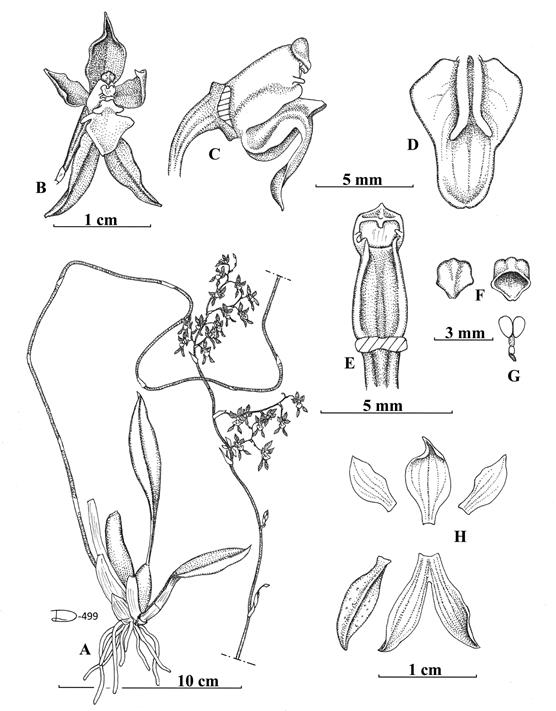
A. Plant habit.
B. Flower, front view.
C. Lip and column, lateral view. Lip flattened, ventral view.
E. Column, ventral view.
F. Anther cap, front and ventral views.
G. Pollinarium.
H. Flower dissected.
The drawing by Delsy Trujillo is based on the holotype and inked by Stig Dalström.
Figure 3 Cyrtochilum pollex Dalström & D.Trujillo.
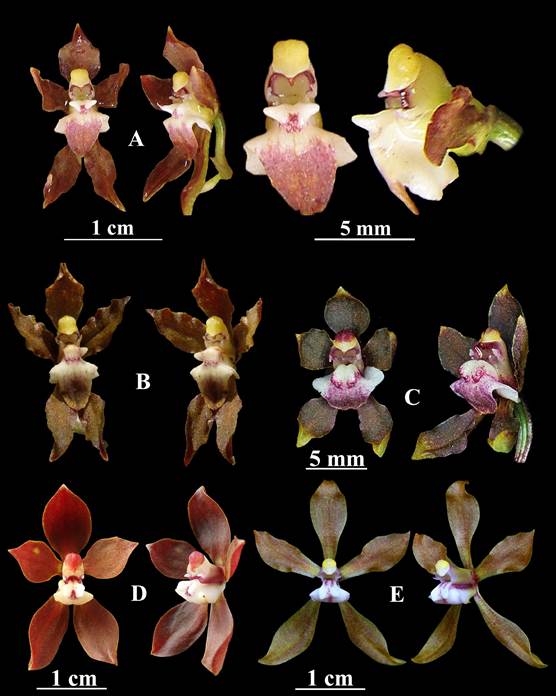
A. Cyrtochilum pollex (D. Trujillo 499).
B. Cyrtochilum pol lex (S. Dalström 3679).
C. Cyrtochilum fidicularium (S. Dalström s.n.).
D. Cyrtochilum gracile (S. Dalström 3807).
E. Cyrtochilum longifolium (G. Deburghgraeve s.n.).
Photos by Delsy Trujillo (A), Stig Dalström (B-D), and Guido Deburghgraeve (E).
Figure 6 Plate of Cyrtochilum pollex and similar species.
Paratype: Peru. Huánuco: Road from Pillao to Miraflores, S09°45.57’; W75°56.104’, alt. 3056 m, 27 Nov. 2013, S. Dalström 3679, photo record (Dalström archives).
Distribution: Cyrtochilum pollex is known from the type collection in the Department of Amazonas and a second locality in the Department of Huánuco, Peru. Plants were found growing as epiphytes in shrubby and mainly disturbed or deforested areas above 3000 m of elevation.
Etymology: Named in reference to the tiny thumb-like appendage (Latin: pollex), on each side of the stigma.












 uBio
uBio 

